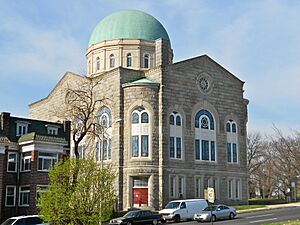History of Russians in Baltimore facts for kids
The history of Russians in Baltimore tells the story of people from Russia who have made Baltimore their home. This community started in the mid-1800s and has grown a lot over time. In the past, many Russians lived in East Baltimore. Today, you'll find most Russians in Northwest Baltimore, especially in the Arlington neighborhood, and in the nearby suburb of Pikesville.
Contents
Who Are the Russians in Baltimore?
How Many Russians Live in Baltimore?
In 1920, about 4,600 people in Baltimore who were born in other countries spoke Russian as their first language. Russian was the second most common Slavic language spoken by immigrants in the city, after Polish.
By 1930, people born in Russia were the largest group of foreign-born residents in Baltimore. About 17,500 people born in Russia lived in the city. More than 24,000 Baltimoreans had parents who were from Russia.
In 1940, about 14,670 immigrants from the Soviet Union lived in Baltimore. Many of these people were of Russian background. They made up about a quarter of all white immigrants in the city.
During the 1990s, around 8,200 immigrants came to Baltimore from Russia, Ukraine, and other countries that used to be part of the Soviet Union.
By 2000, the Russian community in the greater Baltimore metropolitan area had grown to about 35,763 people. This was about 1.4% of the area's total population. In Baltimore city itself, there were 5,526 Russians, making up 0.8% of the city's population. Many Russians also lived in Baltimore County, next to the city.
Languages Spoken
According to the 2000 Census, 1,235 people in Baltimore spoke the Russian language at home.
By 2005, the Baltimore area had the 15th largest group of Russian-speaking people in the United States.
In 2011, immigrants from Russia were the 26th largest group of foreign-born people in Baltimore. The Russian language was the sixth most spoken language among those who did not speak English very well.
In 2013, it was estimated that about 5,647 Russian-Americans lived in Baltimore city.
A Look Back: History of Russians in Baltimore
Most Russian immigrants who came to Baltimore were Russian Jews. In 1930, most of the 17,000 Russians living in the city were Jewish. Unlike the wealthier German Jews in Baltimore, Russian Jews were often poor. They lived in neighborhoods with other Russians. Because of this, many Russian Jews felt more connected to the Russian community than to the larger Jewish community.
The first big wave of Russian-Jewish immigrants came to Baltimore in the 1880s. A second wave arrived in the 1990s, after the Soviet Union broke apart.
Baltimore's Russian community, including Russian Jews, first settled in Southeast Baltimore.
Russian Communists in Baltimore
In the 1920s, some Russians in Baltimore were part of the Communist Party of Maryland. This party had a special Russian branch. Members of this group sometimes went to the Independent Russian Orthodox Church in Baltimore. The leader of the Russian Communist branch, Prokope Suvorov, even taught Russian at the church. Other members sold Communist books there.
Religious Life
While most people of Russian background in Baltimore are Jewish, many are Christians. Most of these Christians belong to the Russian Orthodox Church. Ethnic Russians from Belarus started the Transfiguration of our Lord Russian Orthodox Church in 1963. This church was created to serve the Russian Orthodox community. Russian Orthodox Christians also built the Holy Trinity Russian Orthodox Church.
Russian Jews helped build several synagogues in Baltimore. These include the B'nai Israel Synagogue and the Shaarei Tfiloh Synagogue.
Helping New Immigrants
To help Russian immigrants settle into American life, the Baltimore branch of HIAS started a newspaper in May 1978. It was called The News Exchange and was printed in both Russian and English.
By 1990, over 30,000 people of Russian background lived in Baltimore and Baltimore County. At that time, more than 400 Russian-speaking people moved to the Baltimore area each year.
Russian Culture in Baltimore

In 1995, a newspaper called Kaskad (which means Cascade) was started. It was published every two weeks in the Russian language by a Jewish immigrant from Belarus.
By 1995, the Baltimore area had several Russian grocery stores. There was also a Russian language magazine and a Russian language radio show.
Russian Festival
Every October, the Holy Trinity Russian Orthodox Church holds an annual Russian Festival. This festival celebrates Russian traditions, history, and food.
National Slavic Museum
The National Slavic Museum opened in 2012. This museum focuses on the history of Slavic people in Baltimore, including the city's Russian history.
Lemko House
The Lemko House is an apartment building on South Ann Street. It provides homes for immigrants from Eastern Europe. It was started in 1983 by Ivan Dornic, a priest from an Eastern Rite church. The building is named after Dornic's ethnic group, the Lemkos. The Lemkos are a Rusyn group from a region that covers parts of Slovakia, Poland, and Ukraine. While Lemko House welcomes low-income residents of any background, many Slavic and Eastern European immigrants, including Russians, still live there.
Famous Russian-Americans from Baltimore

Many people of Russian background from Baltimore have become well-known. Here are a few:
- Ben Cardin: A politician who is a United States Senator for Maryland.
- Cass Elliot (Mama Cass): A famous singer and a member of the music group The Mamas & the Papas.
- Barry Levinson: A writer, director, and producer of movies and TV shows who has won an Academy Award.
- Jessica Long: A United States Paralympic swimmer who holds many world records.
- Tatyana McFadden: A United States Paralympian athlete who competes in wheelchair racing.
- Victor Posner: A businessman known for being one of the highest-paid business executives of his time.
- Carroll Rosenbloom: A businessman who owned the Baltimore Colts and the Los Angeles Rams football teams.
- Leon Uris: A novelist famous for his historical fiction books.



